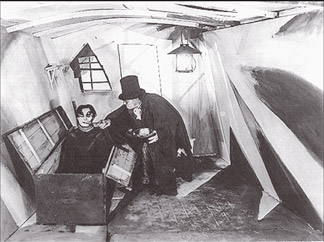|
Film Appreciation:
Early Western and silent films
K S Sivakumaran
Students of cinema and real enthusiasts of seeing artistic films of
any kind around the world should have an opportunity to see western
silent films as well. Let us remind ourselves of some of these films:
The Cabinet of Dr Calligari made in 1919 is such a film. This German
film was directed Robert Wiene. This was one of the early horror films,
one might say.
| Focus on film-makers
* Robert Wiene
* Siegried Kracauerau
* Barry Solt
* Anos Vogal
* Erik Barnouw
* Carl Theodore
* Paul Schradar
* Donal Skoller |
 |
|
The Cabinet
of Dr Calligari |
“It is the story of a mad magician Caligari who hypnotizes a
somnambulist to carry out his murders. Later it was found to be the
director of an asylum who has gone mad in his greed for power and his
obsessive efforts to re-enact a 18th century showman’s murders by proxy.
But at the end of the film we see that the narrator, who so convincingly
tells the story, is himself insane. And Dr Caligari is the benevolent
director of the asylum who understands the case of this young man.”
(Note by my lecturer)
Having understood what the story was about let’s observe what critics
have said about the significance of the film and its impact on German
and World Cinema.
To know more about the early German Cinema in particular the
following books may be useful. From Caligari to Hitler – a psychological
study of the German film by Siegried Kracauerau, From Caligari to who?
by Barry Solt and Film as Subversive Art by Anos Vogal.
Critics say that this film was “an extraordinary work in terms of
theme, form and subsequent impact in cinema. The narrative significance
is in its simultaneously present view points: that the narrator is mad
and the story is partially or totally illusional; or that as is assumed
throughout most of the film, the story is true.”
The critics explain that “This play with reality raises metaphysical
questions and problems of contradictory understanding relevant for any
period of human history. At the same time the film mirrors the inherent
tensions of the collective German psyche of that period.”
I saw this film for the first time in 1990 at the Iffi, but must
confess that I didn’t much like it for the simple reason that I didn’t
know much about Expressionism then.
Film historians say that Dr Caligari was the first significant German
Expressionism. As some of my friends at the Film Appreciation course
remarked ‘truly a hallucinatory film’ it was.
I would like to see the film now and record my impressions.
Hopefully, the Indian Cultural Council’s envisaged program of Film
Appreciation Course in Colombo would include this film s well.
Talking of Silent Films, we must also see the American film Nanook of
the North made by Robert Flaherty in 1922. This is a film about one
single Eskimo family in the Arctic region. The climate there as we could
guess must be very harsh. One experiences visual delight in watching the
magnificent photography of the film. True, it was a documentary, but one
could imagine how the region would have been before the advent of
modernization.
We could also refer to the book Documentary: a history of the
non-fiction film by Erik Barnouw and The innocent Eye by Arthur Calder-
Marshall.
Battleship Potemkin is yet another classic silent film that should
not be missed. It was made in 1925. A theoretician and practicing cinema
genius was the Russian Sergei M Eisenstein. The film is about a mutiny
on board of the Battleship Potemkin. Why it occurred was the refusal of
the sailors to eat a soup of meat crawling with maggots.
According to critics the film shows ‘how individual resistances to a
tyranny build up into a group and then to a mass up rise.
The scene on the steps of Odessa of the tension and tragedy is
beautifully captured in the camera by Eduard Tisse.
Sergei Eisenstein’s writing on Film Form, Film Sense and Notes of a
Film Director are useful reading to understand the cinema in its early
stages.
Finally, let’s know something about the French film The Passion of
Joan of Arc by Carl Theodore Dreyer made in 1928. We have read about the
historical character Joan of Arc. The heroic woman had to struggle
against two obstacles: one between her and her captors (the English army
and the French clergy) and the other within her own self.
One critic aptly described that” the filmmaker’s genius renders the
sequences fluid, dramatic and rhythmic.”
To read about the director we could depend on Transcendental Style in
Film by Paul Schradar and Dreyer in Double Reflection by Donal Skoller
and Speaking of the Language of Desire by Raymond Carney.
Of course the present younger generation of filmgoers would like more
of the Hollywood Science Fiction films, but a serious student of cinema
has got to study the silent era films too.
[email protected]
|



